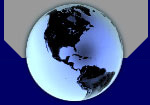Shield volcanoes
Hawaii and Iceland are examples of places where volcanoes extrude huge quantities
of lava that gradually build a wide mountain with a shield-like profile. Their lava flows are generally very hot and
very fluid, contributing to long flows. The largest lava shield on Earth, Mauna Loa, is 9,000 m tall (it sits on the sea floor),
120 km in diameter and forms part of the Island of Hawai. Olympus Mons is a shield volcano on Mars, and the tallest mountain
in the known solar system. Smaller versions of the "lava shield" include the 'lava dome' (tholoid), 'lava cone', and 'lava
mound'.
Volcanic cones or cinder cones result from eruptions that throw out mostly small pieces of rock that build up around
the vent. These can be relatively short-lived eruptions that produce a cone-shaped hill perhaps 30 to 300 m high.
Stratovolcanoes or composite volcanoes
These are tall conical mountains composed of both lava flows and ejected material, which form
the strata that give rise to the name. Classic examples include Mt. Fuji in Japan and Mount Mayon in the Philippines. Volcanoes
on land often take the form of flat cones, as the expulsions build up over the years, or in short-lived volcanic cones, cinder
cones.
Supervolcanoes
Supervolcano is the popular term for large volcanoes that usually have a large caldera and can potentially produce
devastation on a continental scale and cause major global weather pattern changes. Potential candidates include Yellowstone
National Park and Lake Toba, but are hard to identify given that there is no formal definition of the term.
Submarine volcanoes
Submarine volcanoes are common features on certain zones of the ocean floor. Some are active at the present time
and, in shallow water, disclose their presence by blasting steam and rock-debris high above the surface of the sea. Many others
lie at such great depths that the tremendous weight of the water above them results in high, confining pressure and prevents
the formation and explosive release of steam and gases. Even very large, deepwater eruptions may not disturb the ocean surface.
Under water, volcanoes often form rather steep pillars and in due time break the ocean surface in new islands.

